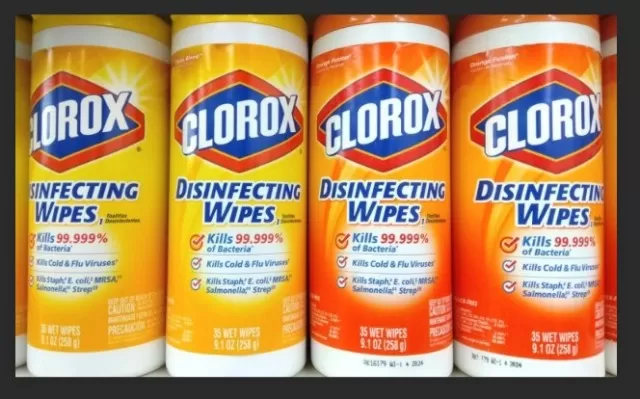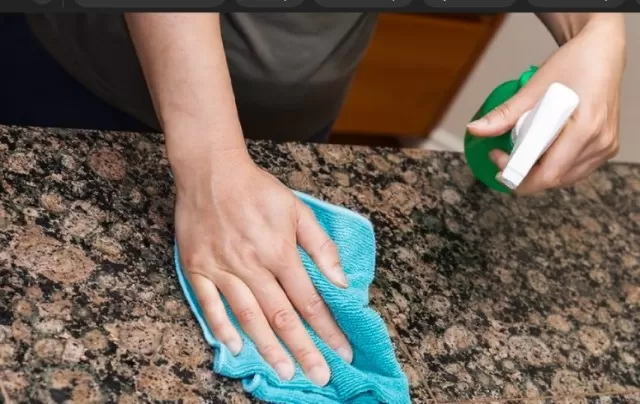Instances to Avoid Clorox Wipes: Wise Usage Tips. In the modern pursuit of cleanliness, the convenience of disinfecting wipes stands as an embodiment of efficiency. A single swipe promises to banish germs, ushering in a realm of pristine surfaces. Yet, before you embark on a cleansing spree, take a moment to absorb this crucial reminder – a safeguard against inadvertent mishaps that could mar the very surfaces you seek to purify.
The allure of disinfection might draw you in, but it is essential to recognize that not all surfaces are created equal. The power of these wipes, while potent against germs, can also harbor the potential for unintended consequences. A hasty, uninformed swipe can inadvertently leave a trail of damage, discoloration, or wear.
In your pursuit of hygiene, embrace the wisdom of informed decision-making. Delve into the realm of compatibility between wipe and surface, understanding the nuances of materials, finishes, and sensitivities. Whether it’s a wooden countertop, a delicate appliance, or a prized possession, each surface tells a story that demands respect and care.
To Cleanse or Abstain? The Dilemma of Disinfecting Surfaces

In our ever-connected world, microscopic inhabitants known as germs are unwavering companions, prompting a pressing question: should we embrace the convenience of disinfectant products like Clorox wipes? These unassuming sheets, readily available at local grocery stores or through the virtual aisles of Amazon, offer the promise of vanquishing 99.
9 percent of viruses and bacteria that lurk on various surfaces. They find homes beneath sinks, within car compartments, and even nestled within purses, standing as stalwart defenders of cleanliness.
However, the decision to wield a Clorox wipe demands a moment’s pause – a contemplative consideration of whether this powerful tool is indeed compatible with the specific mess at hand.
The modern world has accustomed us to a quick fix, a rapid solution to eradicate germs and maintain a sterile environment.
Clorox wipes have become emblematic of this desire for instant cleanliness, their ubiquity reflecting our yearning for efficiency in the battle against microscopic adversaries. Yet, this convenience comes with a caveat, one that advises a modicum of prudence.
Before embarking on a vigorous wiping spree, it is essential to ascertain the compatibility of these wipes with the surface in question. Not all materials and substances are created equal, and some may react unfavorably to the potent agents housed within these cleansing sheets.
Delving into the world of disinfectants unveils a nuanced landscape of considerations.
A misinformed swipe of a Clorox wipe might inadvertently mar a cherished surface, leaving behind unintended consequences. It is, therefore, imperative to make informed choices – to equip oneself with knowledge about the chemicals in these wipes, their efficacy against various pathogens, and their potential impact on different materials.
The decision to wield or withhold a Clorox wipe thus becomes a careful assessment of risk versus reward.
In the grand theater of hygiene, the question of whether to wipe or not to wipe extends beyond mere utility; it encapsulates a fundamental choice between embracing modern cleanliness conveniences and heeding the potential repercussions of hasty disinfection.
The answer lies not only in the efficacy of the product but also in the wisdom and prudence of its application. So, as we navigate the landscapes where germs persist, armed with our trusty Clorox wipes, let us remember that knowledge and discernment are the allies that ensure our pursuit of cleanliness is a harmonious one.
Caring for Your Complexion: The Distinctive Domain of Clorox Wipes
While the distinction might seem obvious, it bears repeating: Clorox wipes and baby wipes are unequivocally not interchangeable.
The rationale behind this differentiation lies embedded in the nature of the chemicals residing within these sheets of cleanliness. Designed with a specific purpose in mind, Clorox wipes emerge as steadfast companions in the quest for pristine surfaces, carved with a mission to vanquish germs and impurities from hard, unyielding materials.
Yet, it’s a notion that sometimes warrants revisitation, especially in a world where multitasking has become a norm.
In the vast panorama of household essentials, it’s crucial to appreciate the role exclusivity plays in the realm of cleanliness. Clorox wipes, fortified with potent disinfectants, aren’t fashioned to caress your skin, pamper your child’s delicate epidermis, or be brushed against the velvety fur of your beloved pet.
.
The chemicals composing Clorox wipes, meticulously curated for the rigors of surfaces, can embark on an entirely different journey when confronted with the tenderness of skin or the innocence of youth.
The fragility of human skin, the vulnerability of infantile complexions, and the unique sensitivities of various animals necessitate a more discerning touch – one that is underpinned by formulations and ingredients designed exclusively for such purposes.
So, as we navigate the pathways of hygiene and cleanliness, let this be a steadfast reminder: the pristine purity of Clorox wipes might find their glory in the sheen of countertops, doorknobs, and myriad surfaces, but they stand far afield from the delicate landscapes of skin, the ephemeral grace of infancy, and the furry embrace of our pets.
In a world abundant with specialized solutions, may our choices reflect an understanding of each product’s rightful place and a commitment to the well-being of all that resides within our care.
Preserving the Panache of Granite: A Cautionary Tale for Clorox Wipes

The kitchen, a realm of culinary creation and communal gatherings, often plays host to a battle against bacteria and stubborn stains.
Among the arsenal of cleaning allies, the convenience of Clorox wipes stands unrivaled – a quick swipe to disinfect, eliminate crumbs, and vanquish stubborn cooking residues. However, as we navigate the intricate landscape of kitchen hygiene, a particular caveat beckons our attention, especially when it comes to granite countertops.
The allure of using Clorox wipes on granite surfaces is undeniable.
Their effortless efficiency in tackling messes makes them an appealing choice for swift kitchen upkeep. But as we dig beneath the surface, a hidden truth comes to light.
Granite, a majestic testament to the Earth’s geological artistry, harbors a delicate secret – its porous nature. To shield its splendor and stave off the effects of time, granite is often sealed, creating a protective barrier against the elements.
Enter Clorox wipes, armed with their potent disinfectant properties.
Though formidable allies for many battles, they harbor an unintended consequence when deployed against granite. Their active agents, while adept at battling germs and stains, can unknowingly wage war on the very sealant designed to protect the granite’s beauty.
A seemingly innocuous wipe can gradually erode the sealant, leaving the granite’s lustrous exterior exposed to potential damage.
The harmony between cleaning and preservation is a delicate dance, one that necessitates informed decisions.
When the surface in question is as regal as granite, such consideration becomes paramount. Before each swipe, a moment of contemplation is warranted – a pause to weigh the benefits of cleanliness against the potential cost to the countertop’s integrity.
So, as the heart of your home remains a canvas for culinary exploration and shared memories, remember this tale of caution.
While the allure of Clorox wipes beckons, let the wisdom of preservation guide your hand. Embrace alternative solutions, tailored to the unique nature of granite, and ensure that the timeless beauty of your countertops continues to grace your kitchen for generations to come.
Guarding Your Palate: A Word of Caution Against Clorox Wipes for Tableware
In the bustling rhythm of daily life, the allure of quick solutions often holds sway.
When faced with a dirty dish, tarnished silverware, or a smudged glass, the convenience of Clorox wipes might seem like an enticing remedy. However, this seemingly effortless shortcut carries hidden risks, especially when it comes to items that come in contact with your mouth.
Consider this a resounding reminder: Clorox wipes are not intended for cleaning anything that your mouth will soon embrace.
Beneath their cleansing prowess lie chemical constituents that might wield potential harm if inadvertently ingested. The ease of a swipe and a wipe may disguise the perilous journey that these chemicals could embark upon.
In the realm of food and drink, safety is paramount.
The utensils and vessels that ferry sustenance to our lips should be vessels of purity, free from the specter of chemical residues. While Clorox wipes excel at their designated task of disinfecting surfaces, their suitability falters when confronted with tableware.
The synergy between hygiene and health requires a more nuanced approach – one that ensures cleanliness without compromising the safety of what we consume.
So, let this serve as a steadfast guideline in your household routines.
As tempting as it might be to streamline your cleanup efforts, the well-being of those around your table takes precedence. Seek out alternatives that align with the unique needs of your dining wares, embracing solutions that harmonize with the sanctity of your culinary experiences.
In doing so, you uphold a tradition as old as time – the pursuit of nourishment, shared moments, and the safeguarding of those you cherish.
Preserving Clarity: A Prudent Reminder for Eyeglass Care

In the realm of daily rituals, the quest for clarity often leads us to our eyeglasses, those trusty companions that illuminate the world around us.
Yet, in moments of resource scarcity, the temptation to improvise solutions can overshadow our better judgment. The siren call of a Clorox wipe, absent lens wipes, might beckon, but consider this a gentle cautionary note: restraint is advised.
When the canvas is your eyewear, every detail matters.
While Clorox wipes are adept warriors in the crusade against germs, their foray into eyeglass maintenance is a venture better left unexplored. The chemicals nestled within these wipes, designed for the rigors of surface cleaning, may harbor the potential for mild discomfort if they make direct contact with your eyes.
A quest for clarity can swiftly turn into a pursuit of relief, and the prospect of an uncomfortable interaction with these chemicals necessitates a level of vigilance.
The eyes, those windows to the soul, deserve a measure of reverence.
As you stand at the crossroads of necessity and innovation, consider this a plea for discernment. When lens wipes are but a memory, explore alternative routes to keep your eyeglasses pristine – avenues that don’t lead you perilously close to the realm of discomfort.
Remember that clarity, in all its facets, is a treasure worth safeguarding.
An oversight in the quest for cleanliness can inadvertently lead to unwelcome complications. So, let this be a reminder etched in your eyewear routine: exercise prudence, embrace alternative solutions, and ensure that the world you perceive remains a canvas of crisp, unobstructed vision.
*The information is for reference only.